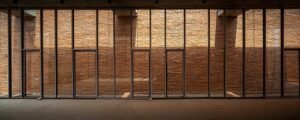Elephants have a special status in Thailand. Starting with such a description, and keeping in mind the importance of elephants, Architects deduced the concept for the Museum. The community has lived with elephants that their ways of life, from birth to death, can hardly be separated.

Planning :
The planning is done such that it is portraited to be a maze, which is made of brick walls, with the indoor-outdoor relationship. Since the relationship between the Kui people and elephants has been given the dignity of the familial relationship, the museum is a tribute for the ones who’re gone. It is also a calling for elephants who’ve left, and villagers want them to call back to their homeland. According to the planning, the galleries would open to another one, through the opening in the wall, which is kept large and transparent.
It’s amazing how architecture can change the meaning of a building from a name to a relationship, a significant epitome.

Materials :
Since the walls act as a maze, they erect from the vast treeless land, sprouting into a beautiful puzzle, which through the slopes lead people inside the museum through the directive walls, made of bricks. Courtyards of different shapes and sizes open up from the four exhibition galleries. Some are filled with small pools, some with reddish earth just like the landscape outside.

The material has been specially chosen, keeping in mind the cultural aspect of the place. The bricks are made from the traditional technique that was passed from generations among the people of Thailand. They are fired bricks hand-made, with the help of loom. It is made of a 1000 bricks, beautifully woven to send the message of ‘co-existence of humans and animals’.
The project is divided into four parts :
- First Area : consists of a reception hall, the main exhibition room, a library, a research room, a seminar room, a coffee shop, and a gift shop which through zoning would signify public utilities.
- Second, Third, and Fourth area are Museums. All of the museums signify a different lesson. The first museum portrays the relationship between people and elephants. The second one signifies deforestation and how elephants struggled for sustenance. The third one delineates the emotions of people for empowerment.
Conclusion :
All the walls come out as a surprising element for the museum, which separating the spaces through courtyards, planters, and pools. Space has been created such that it describes the tranquillity people have been looking for, but the search doesn’t end. The play of shadows and light gives playfulness to the sturdy built of the museum, while to keep it engaging, the maze has been used as the planning of the museum.

photography: spaceshift studio


